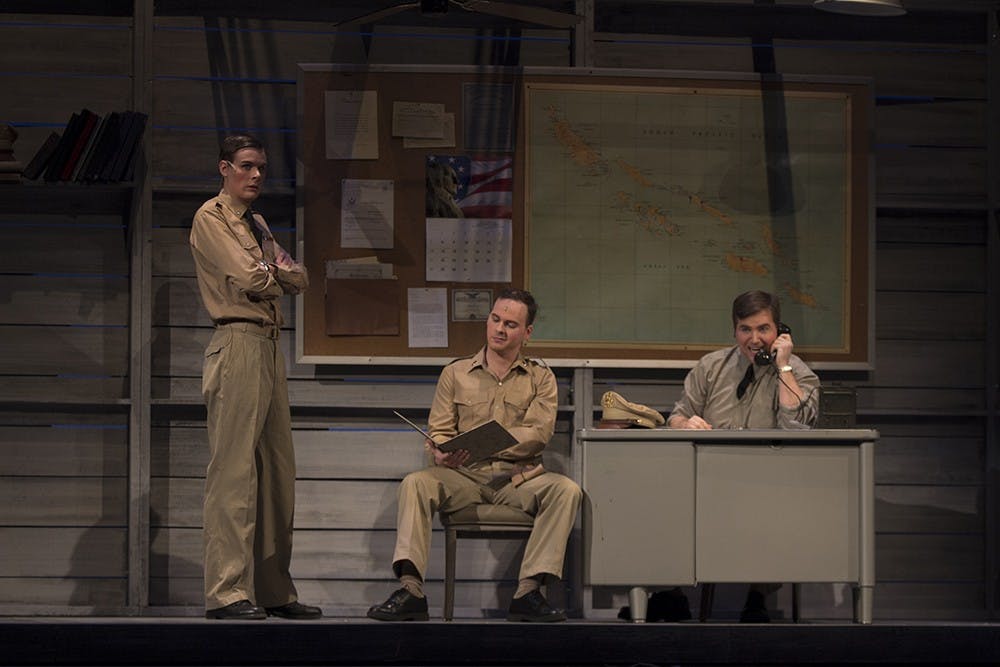The World War II-themed musical opens at 8 p.m. Friday at the Musical Arts Center.
The show focuses on the experiences of soldiers stationed on an island in the South Pacific. The story dives deeper into America’s history as the characters meet the island’s Polynesian inhabitants and struggle with conforming to racist societal norms.
The show is double-casted, meaning there are two actors for every part.
Jessamyn Anderson plays Nellie Forbush, a cheerful, naïve U.S. Navy nurse who is stationed on the island.
She meets and falls in love with Emile de Becque, a French plantation owner. However, she struggles to accept the idea that he has mixed-race children. Anderson said the biggest aspect of her character she had to conquer was the difference in their upbringing.
“We’ve grown up in a place where racism is wrong,” Anderson said.
This wasn’t the case for her character, Forbush.
“South Pacific” was written in the late 1940s, right after World War II ended. In those days, racism had a more common place in American culture. While racism still exists today, Anderson said it didn’t have such an obvious and public role as it did when the musical was first released.
“One of the hardest things is trying to figure out where she’s coming from,” she said.
This show is special because the antagonist is not a single person, she said, it’s a notion. It’s racism as a whole.
“‘South Pacific’ was one of the first musicals to deal with serious subject matter,” Vince Liotta, stage director for “South Pacific,” said.
Bruno Sandes plays Emile de Becque, Anderson’s middle-aged love interest. Jóhann Schram Reed also plays Becque in two of the production’s shows.
One of his favorite parts about the show is that the plot was created organically. The drama is not something writers Rodgers and Hammerstein made up. Instead, they picked up on taboo cultural problems, he said.
“They talk about something everybody avoids talking about,” he said. They weren’t scared of?conflict.
Part of the musical’s success comes from the fact that it communicates a message without making it feel insignificant or boring. How does it do this? Through song.
Music is more effective at communication than speaking, Sandes said. It’s because the melody pulls people.
The music keeps spinning in your mind, he said, and in turn strengthens the musical’s anti-?racist message.
“They (Rodgers and Hammerstein) expose all of the ugliness,” he said. “It’s really powerful.”
Like Sandes, Anderson said music influences emotion. It’s more powerful than the spoken word. Without the music, the dialogue is naked, she said.
Anderson described how racism is musically depicted to solidify her point. In the beginning of the show, the racist undertones are more subtle. There is not as much music underscoring the dialogue. However as the plot thickens and race becomes a bigger factor, the music builds in the ?background.
“It’s easier to hear when it’s trapped in something beautiful,” she said of “South Pacific’s” social criticism. “You get truth that’s hidden in this beautiful art form.”
Sandes said this show acts like a mirror. It’s a show that makes people think, ?he said.
“I think we see ourselves in this show,” he said. “The problems that they were facing at that time was not so different from today.”
People still don’t know how to deal with the difference, Sandes said. Even ?after 50 years.
Sandes said he wants people to open their hearts when they watch his performance. “South Pacific” has the capability to use music and comedy to push people forward, to keep growing.
“We are all human beings,” he said. “We are still learning.”






